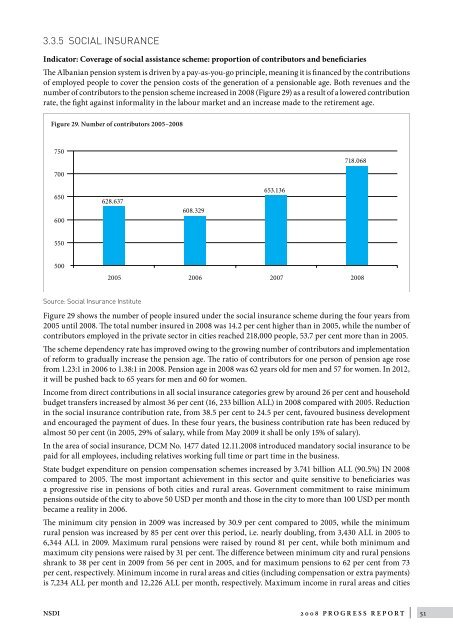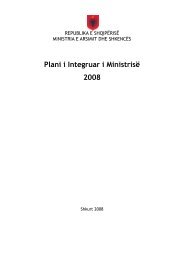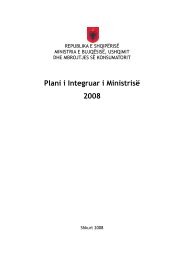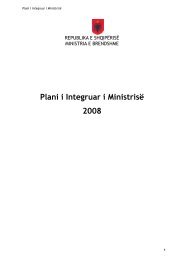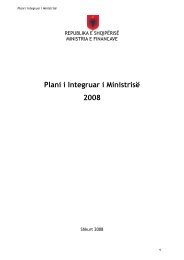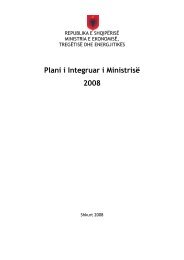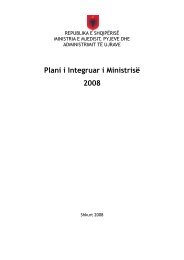Department of Strategy and Donor Coordination
Department of Strategy and Donor Coordination
Department of Strategy and Donor Coordination
Create successful ePaper yourself
Turn your PDF publications into a flip-book with our unique Google optimized e-Paper software.
3.3.5 Social insurance<br />
Indicator: Coverage <strong>of</strong> social assistance scheme: proportion <strong>of</strong> contributors <strong>and</strong> beneficiaries<br />
The Albanian pension system is driven by a pay-as-you-go principle, meaning it is financed by the contributions<br />
<strong>of</strong> employed people to cover the pension costs <strong>of</strong> the generation <strong>of</strong> a pensionable age. Both revenues <strong>and</strong> the<br />
number <strong>of</strong> contributors to the pension scheme increased in 2008 (Figure 29) as a result <strong>of</strong> a lowered contribution<br />
rate, the fight against informality in the labour market <strong>and</strong> an increase made to the retirement age.<br />
Figure 29. Number <strong>of</strong> contributors 2005–2008<br />
750<br />
718.068<br />
700<br />
650<br />
600<br />
628.637<br />
608.329<br />
653.136<br />
550<br />
500<br />
2005 2006 2007 2008<br />
Source: Social Insurance Institute<br />
Figure 29 shows the number <strong>of</strong> people insured under the social insurance scheme during the four years from<br />
2005 until 2008. The total number insured in 2008 was 14.2 per cent higher than in 2005, while the number <strong>of</strong><br />
contributors employed in the private sector in cities reached 218,000 people, 53.7 per cent more than in 2005.<br />
The scheme dependency rate has improved owing to the growing number <strong>of</strong> contributors <strong>and</strong> implementation<br />
<strong>of</strong> reform to gradually increase the pension age. The ratio <strong>of</strong> contributors for one person <strong>of</strong> pension age rose<br />
from 1.23:1 in 2006 to 1.38:1 in 2008. Pension age in 2008 was 62 years old for men <strong>and</strong> 57 for women. In 2012,<br />
it will be pushed back to 65 years for men <strong>and</strong> 60 for women.<br />
Income from direct contributions in all social insurance categories grew by around 26 per cent <strong>and</strong> household<br />
budget transfers increased by almost 36 per cent (16, 233 billion ALL) in 2008 compared with 2005. Reduction<br />
in the social insurance contribution rate, from 38.5 per cent to 24.5 per cent, favoured business development<br />
<strong>and</strong> encouraged the payment <strong>of</strong> dues. In these four years, the business contribution rate has been reduced by<br />
almost 50 per cent (in 2005, 29% <strong>of</strong> salary, while from May 2009 it shall be only 15% <strong>of</strong> salary).<br />
In the area <strong>of</strong> social insurance, DCM No. 1477 dated 12.11.2008 introduced m<strong>and</strong>atory social insurance to be<br />
paid for all employees, including relatives working full time or part time in the business.<br />
State budget expenditure on pension compensation schemes increased by 3.741 billion ALL (90.5%) IN 2008<br />
compared to 2005. The most important achievement in this sector <strong>and</strong> quite sensitive to beneficiaries was<br />
a progressive rise in pensions <strong>of</strong> both cities <strong>and</strong> rural areas. Government commitment to raise minimum<br />
pensions outside <strong>of</strong> the city to above 50 USD per month <strong>and</strong> those in the city to more than 100 USD per month<br />
became a reality in 2006.<br />
The minimum city pension in 2009 was increased by 30.9 per cent compared to 2005, while the minimum<br />
rural pension was increased by 85 per cent over this period, i.e. nearly doubling, from 3,430 ALL in 2005 to<br />
6,344 ALL in 2009. Maximum rural pensions were raised by round 81 per cent, while both minimum <strong>and</strong><br />
maximum city pensions were raised by 31 per cent. The difference between minimum city <strong>and</strong> rural pensions<br />
shrank to 38 per cent in 2009 from 56 per cent in 2005, <strong>and</strong> for maximum pensions to 62 per cent from 73<br />
per cent, respectively. Minimum income in rural areas <strong>and</strong> cities (including compensation or extra payments)<br />
is 7,234 ALL per month <strong>and</strong> 12,226 ALL per month, respectively. Maximum income in rural areas <strong>and</strong> cities<br />
NSDI 2008 Progress Report | 51


